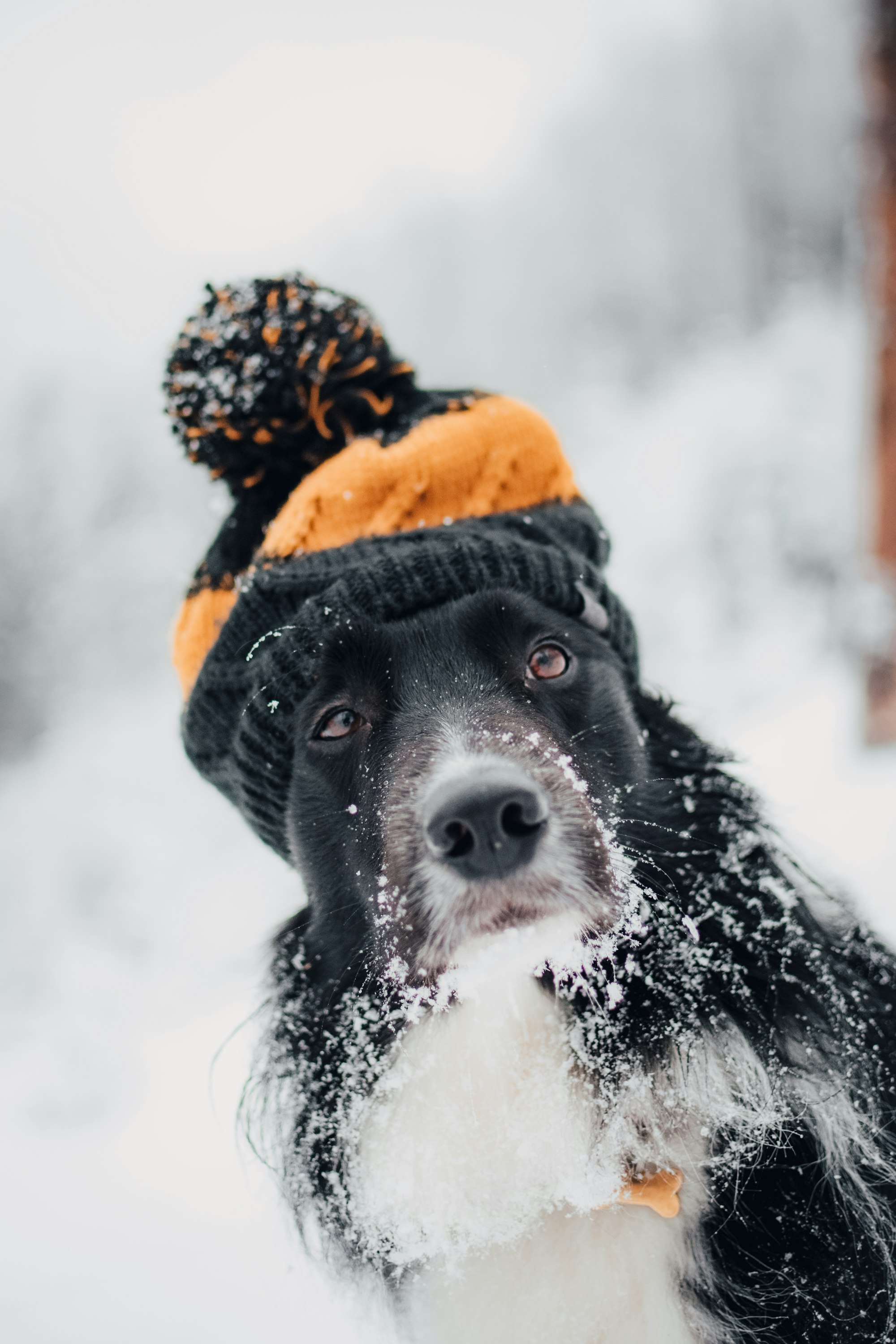As pet owners, we cherish the joy and companionship our furry friends bring to our lives. Just as we prioritize our comfort and safety during chilly weather, it's equally crucial to ensure our beloved dogs are well-protected from the cold. But have you ever wondered, what temperature is too cold for dogs? Here, we'll delve into this critical question and offer valuable insights to keep your four-legged companion warm, healthy, and happy.

Understanding Dogs and Cold Sensitivity
Dogs, just like humans, have varying degrees of sensitivity to cold temperatures. This sensitivity depends on factors such as breed, size, and overall health. Some dogs are naturally better equipped to handle colder weather due to their genetics and coat type, while others may struggle in chilly conditions.

Factors Affecting Cold Tolerance
When considering a dog's ability to tolerate cold, several key factors come into play:
1. Breed Origin and Adaptations
Certain breeds have evolved in colder climates and possess adaptations that enable them to thrive in low temperatures. Breeds like the Alaskan Malamute and Newfoundland have thick coats and robust physiques that provide natural insulation.
2. Coat Type and Thickness
A dog's coat acts as its primary defense against the cold. Breeds with double coats, consisting of a soft undercoat and a weather-resistant outer coat, are generally better equipped for colder conditions. In contrast, dogs with short or single coats might need extra protection.
3. Body Size and Mass
Larger dogs tend to retain body heat more effectively than smaller ones due to their higher mass-to-surface area ratio. This is why smaller breeds, such as the Chihuahua, might be more sensitive to cold.
4. Age and Health
Puppies and senior dogs are often more vulnerable to extreme temperatures. Their bodies might not regulate temperature as efficiently as those of adult dogs in their prime. Additionally, dogs with underlying health issues might have a reduced ability to tolerate colds.
5. Activity Level
Active dogs generate more body heat through movement and metabolism. Dogs that are more sedentary may feel the cold more intensely, especially if they're not expending energy to stay warm.
By understanding these factors, you can better assess your dog's tolerance to colds and take appropriate measures to keep them safe and comfortable.
Signs of Cold Distress in Dogs
Recognizing signs of distress in dogs due to cold weather is crucial for their well-being. Here's a stepwise guide to help you identify these signs:
- Shivering: One of the most common signs of cold distress in dogs is shivering. If you notice your dog's body shaking involuntarily, it's an indication that they're feeling too cold.
- Whining or Vocalization: Dogs may whine, whimper, or bark more than usual when they're uncomfortable due to the cold. This vocalization is their way of communicating their discomfort.
- Seeking Warmth: If your dog is actively seeking out warm spots in your home, such as curling up near heaters or snuggling under blankets, they're trying to regulate their body temperature.
- Curling Up: Dogs will often curl up into a tight ball when they're cold. This position helps them conserve body heat by minimizing the surface area exposed to the cold air.
- Lifting Paws: Cold pavement and snow can be uncomfortable for dogs. If your dog keeps lifting their paws off the ground during walks, it's a sign that their paws are feeling the cold.
- Slowed Movement: Cold temperatures can cause dogs to move more slowly and stiffly. If your dog's movements seem restricted or labored, they might be struggling with the cold.
- Visible Discomfort: Watch for any signs of discomfort, such as rapid breathing, trembling, or reluctance to move. These indicators suggest that your dog is not adapting well to the cold.
Ideal Temperature Range for Different Breeds
Every dog breed has its unique ideal temperature range that they're most comfortable in. While specific preferences may vary, here's a general guideline to help you understand the ideal temperature range for different breeds:

- Cold-Tolerant Breeds: Breeds like Siberian Huskies, Alaskan Malamutes, and Bernese Mountain Dogs have thick double coats and were bred for colder climates. They typically feel most comfortable in temperatures ranging from 20°F to 50°F (-6°C to 10°C).
- Moderate-Tolerant Breeds: Many medium-sized breeds, such as Golden Retrievers, Labradors, and Border Collies, can handle a wider range of temperatures. They tend to be comfortable between 30°F to 70°F (-1°C to 21°C).
- Cold-Sensitive Breeds: Breeds with short coats or less body fat, like Greyhounds and Chihuahuas, have a harder time staying warm in colder conditions. They might prefer temperatures between 40°F to 80°F (4°C to 27°C).
- Senior Dogs: Older dogs, regardless of breed, often struggle more with temperature extremes. Keep a close eye on their behavior and adjust their environment accordingly.
Remember that these temperature ranges are approximate and can vary based on individual factors such as the dog's health, activity level, and acclimatization. Always monitor your dog's behavior and adjust their surroundings to ensure they're comfortable and safe.
Tips to Keep Your Dog Warm
When the temperature drops, ensuring your furry friend stays warm and comfortable is paramount. Here are some effective tips to keep your dog cozy during cold weather:
- Provide Shelter: Ensure your dog has access to a warm and dry shelter. A doghouse or an indoor space with blankets can offer protection from harsh elements.
- Warm Bedding: Use soft and warm bedding materials to create a snug sleeping environment. Consider elevated beds to prevent cold drafts from reaching the floor.
- Limit Outdoor Time: Minimize outdoor exposure during chilly weather, especially if your dog is sensitive to the cold. Short and supervised walks are better than extended stays outside.
- Layer Up: For dogs with short fur or low body fat, consider using dog sweaters or jackets. These clothing items provide an extra layer of insulation to keep them warm.
- Keep Active: Engage your dog in indoor activities and play to generate body heat. Puzzle toys, hide-and-seek, and gentle exercises can help them stay warm and entertained.
- Nutrition Matters: Providing a well-balanced diet helps maintain your dog's energy levels and contributes to their overall warmth. Consult your vet for dietary recommendations tailored to the season.
Dressing Your Dog: Fashion Meets Functionality
Dressing your dog in cold weather isn't just about style; it's about providing practical protection. Here's how to strike the perfect balance between fashion and functionality:
- Choose the Right Fit: Ensure any clothing you choose fits your dog comfortably without restricting movement. Avoid overly tight or loose clothing.
- Consider the Breed: Breeds with thick fur might not need clothing, but short-haired or small breeds can benefit from extra insulation.
- Material Matters: Opt for clothing made from warm and breathable materials. Avoid clothing that can cause chafing or discomfort.
- Protect Vulnerable Areas: If your dog's belly is close to the ground, consider a coat that offers belly coverage. Also, prioritize covering areas like the ears, paws, and tail.
- Introduce Gradually: If your dog isn't used to wearing clothing, introduce it gradually. Let them get accustomed to the clothing indoors before heading outside.
Indoor Comfort and Cozy Beddings
Creating a comfortable indoor environment is essential for your dog's well-being during cold weather. Here's how to ensure your home is a cozy haven:
- Warm Sleeping Spots: Place your dog's bed away from drafts and cold surfaces. Ensure it's in a warm and quiet corner where they can rest undisturbed.
- Use Blankets: Provide soft and warm blankets for your dog to snuggle into. Layering blankets can add extra warmth and comfort.
- Heating Solutions: If your home tends to get chilly, consider using space heaters or heated pet mats to create warm spots for your dog.
- Share Warmth: Dogs love companionship. Allowing your furry friend to curl up near you on the couch or bed provides them with warmth and emotional comfort.
- Monitor Comfort: Pay attention to your dog's behavior. If they seek out warmer spots or seem restless, it might be an indication that they need a more comfortable environment.
By following these tips, you can ensure your dog remains warm, cozy, and content even when the temperatures drop. Remember, your efforts to keep them comfortable are a testament to the love and care you have for your furry companion.
The Importance of Nutrition during Cold Weather
As the temperature drops, your dog's nutritional needs may change. Providing the right diet during cold weather is essential to help them stay warm and maintain their overall health. Here's why nutrition matters:

- Energy Requirements: Cold weather can lead to increased energy expenditure as your dog tries to stay warm. Ensure their diet contains enough calories to meet their energy needs.
- Quality Protein: Protein is crucial for maintaining muscle mass and supporting the immune system. Opt for high-quality protein sources to keep your dog strong and healthy.
- Omega-3 Fatty Acids: These healthy fats support skin and coat health, helping your dog maintain a protective barrier against the cold. Fish oil or foods rich in omega-3s can be beneficial.
- Vitamins and Minerals: Adequate vitamins and minerals, especially vitamin E and zinc, play a role in maintaining a healthy skin and coat. Consult your vet to ensure your dog's diet is well-balanced.
- Hydration: While it might seem counterintuitive, dogs can get dehydrated in cold weather too. Ensure they have access to fresh water at all times.
Exercise and Play: Finding the Right Balance
Staying active is essential for your dog's physical and mental well-being, regardless of the weather. During cold weather, finding the right balance between exercise and indoor play is crucial:
- Indoor Activities: Engage your dog in indoor activities like fetch, tug-of-war, or interactive dog toys. These activities stimulate their minds and help burn energy.
- Short Walks: While outdoor walks are still necessary, keep them shorter during very cold weather. Pay attention to your dog's behavior to gauge their comfort level.
- Warm-Up: Just like humans, dogs benefit from a warm-up before exercise. Start with gentle movements to help their muscles adjust to the cold.
- Avoid Ice: Be cautious of icy surfaces during walks. Ice can be slippery and potentially harmful to your dog's paws.
Grooming Matters: Fur Maintenance in Winter
Proper grooming is essential year-round, even during winter. Here's how to maintain your dog's fur health during the colder months:
- Regular Brushing: Brush your dog's fur regularly to remove loose hair and prevent matting. This improves air circulation and keeps their coat insulating.
- Trimming: For dogs with long hair, consider a light trim to prevent snow and ice from accumulating in their fur. However, avoid shaving them completely, as their coat provides warmth.
- Paw Care: Trim the fur between your dog's paw pads to prevent ice and snow from sticking. Wipe dog paws after walks to remove any harmful chemicals or salt.
- Bathing: While dogs still need baths, avoid excessive bathing during winter as it can dry out their skin. Use a moisturizing shampoo and consult your vet for recommendations.
By focusing on these aspects, you'll ensure your dog's nutritional needs are met, they stay active and engaged, and their fur remains healthy and well-maintained even in the coldest months. Your care and attention will go a long way in keeping your furry friend comfortable and thriving.
Keeping Paws Protected: Dog Booties
Protecting your dog's paws from the harsh elements is crucial during cold weather. Dog booties offer a practical solution to keep their paws safe and comfortable:
- Snow and Ice: Cold surfaces can be harsh on your dog's paw pads. Booties provide a barrier between their paws and the cold ground, preventing ice and snow from causing discomfort or injury.
- Chemicals and Salt: Chemicals and salt used to melt ice on sidewalks can be harmful to your dog's paws. Booties keep their paws clean and shielded from these substances.
- Injury Prevention: In icy conditions, dogs are prone to slipping and injuring themselves. Booties provide traction and stability, reducing the risk of falls.
- Proper Fit: When selecting booties, ensure they fit snugly but not too tight. Booties that are too loose might fall off, while those that are too tight can cause discomfort.
- Gradual Introduction: Some dogs might be hesitant to wear booties at first. Introduce them gradually and use positive reinforcement to associate the booties with positive experiences.
Creating a Dog-Friendly Indoor Environment
A cozy indoor space is essential for your dog's well-being during cold weather. Here's how to create a dog-friendly indoor environment:
- Warm Beds: Provide comfortable, warm bedding for your dog to rest on. Consider adding blankets or heated beds for extra warmth.
- Designated Spaces: Create designated areas for your dog to relax, play, and sleep. This gives them a sense of security and helps establish boundaries.
- Chew Toys and Enrichment: Keep your dog mentally stimulated by offering a variety of chew toys, puzzle feeders, and interactive toys.
- Temperature Control: Maintain a comfortable indoor temperature. If you use a heater, ensure it's safely positioned and doesn't pose a hazard to your dog.
- Indoor Safety: Remove potential hazards from your dog's indoor environment, such as toxic plants, small objects that could be swallowed, and exposed electrical cords.
Health Considerations for Senior Dogs
Senior dogs require special care, especially in colder weather. Here's how to ensure their health and comfort:
- Warmth: Older dogs are more susceptible to the cold. Provide them with extra warmth, such as a heated blanket or sweater.
- Joint Health: Cold weather can exacerbate joint stiffness in senior dogs. Consider joint supplements or medications recommended by your vet to keep them comfortable.
- Regular Vet Visits: Schedule regular check-ups to monitor your senior dog's health. Your vet can guide nutrition, exercise, and any specific health concerns.
- Gentle Exercise: While exercise is essential, opt for gentle activities that don't strain your senior dog's joints. Short walks and indoor play can help them stay active without causing discomfort.
Cold Weather Safety Outdoors
When venturing outdoors with your happy dog during cold weather, safety should be a top priority:
- Short Walks: Keep outdoor walks brief, especially during extremely cold weather. Prolonged exposure to low temperatures can lead to discomfort or even frostbite.
- Paw Care: Apply a paw protectant or balm before going outside to create a barrier between your dog's paws and the cold ground.
- Pet-Friendly Deicers: If using deicers on your property, choose pet-friendly options that are less likely to irritate your dog's paws or be harmful if ingested.
- Supervision: Always supervise your dog while they're outside. Monitor their behavior for signs of distress, and bring them indoors if they show any discomfort.

Wrapping Up
In conclusion, ensuring your dog's well-being during cold weather involves a combination of proper care, attention to their needs, and providing a safe and comfortable environment. By taking steps to protect their paws, create a dog-friendly indoor space, address senior dog health considerations, and prioritize safety during outdoor activities, you're demonstrating your commitment to your furry companion's happiness and health. Remember, your dog's comfort and safety should always be a top priority, regardless of the season.
FAQs About Keeping Your Dog Warm in Cold Weather
- Q1: Can I leave my dog outside in cold weather?
A1: It's best to keep your dog indoors during extreme cold. If outdoor time is necessary, ensure it's brief and supervised.
- Q2: Do all dogs need winter clothing?
A2: No, not all dogs need clothing. Breeds with thick coats might not require additional attire, but short-haired breeds could benefit from it.
- Q3: How can I tell if my dog is too cold?
A3: Watch for signs like shivering, seeking warmth, or lifting paws off the ground. These are indications that your dog might be too cold.
- Q4: Can I use human winter clothes on my dog?
A4: It's better to use specially designed dog clothing. Human clothes might not fit well or provide the needed protection.
- Q5: Are there any indoor activities to keep my dog active in winter?
A5: Yes, you can engage your dog in indoor games like hide-and-seek, puzzle toys, or practicing obedience commands.




